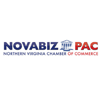As outlined in our Legislative Agenda, the Chamber supports access to a broad energy portfolio that provides the ability for our Region to thrive and grow. According to Statista, over the past 20 years, the United States has continuously had a high demand for energy, coming in second place after China among the world’s main energy consumers. The growth of …
The Power of Networking
There is a well-established adage that people do business with people they trust and like. Networking is a perfect way to develop long-lasting, trusted connections and establish a strong reputation within the business community. According to the Economist Intelligence Unit, 78% of start-up founders say that networking is an integral factor in business success. The Chamber offers numerous ways for …
Talent Up Fairfax: A Talent Recruitment Solution for Fairfax County Employers and Job Seekers
Talent Up Fairfax is an innovative demonstration project in work-based learning (WBL), made possible through funding from the American Rescue Plan Act and the Fairfax County Department of Economic Initiative. The program launched on July 11, 2023, and has been marketed as a talent solution to Fairfax County business and job seekers. This program is particularly designed to forge vital …
Conquering the Skills Gap in the Region with Veteran Employment
There is a massive skills gap in America, with a significant number of the 10 million unfilled jobs in our country going vacant – right here in Northern Virginia, Maryland, and Washington D.C. With these challenges, come unique opportunities for companies to brand themselves as employers that, not only understand the employment landscape, but also the macro and micro factors …
Member Profile: Inclusivity Champion Stephanie Turner
“Diversity refers to more than people; there are dimensions to it. I think of it as a noun that can represent a person, place, thing, or culture. Everything about us is diverse, as we are all unique and individual, just like places and things. Embracing inclusivity means acknowledging that we’re all different and can each offer something special. Therefore, we …
At the Midway Point: 2024 General Assembly Update
Our Region’s future growth and economic stability are top discussion points during this year’s Virginia General Assembly, which began January 7th and will run through March 9th in Richmond. Currently in Week 6, the General Assembly has seen its share of highs and lows, with critical bills centering around taxes, education, and workforce issues. The Chamber’s Vice President of Government …
The Paradox of Big Ideas and Paralyzing Caution
In today’s fiercely competitive and largely fragmented marketplace, you need more than entry-level, safe ideas. You need, shall we say, brass-like fortitude. Yet, when it comes to campaign ideas, many brands get caught at a crossroads. And not the one where you sell your soul to become a legend. (If you ask us, Johnny beat the Devil hands down.) This …
How ISO’s HR Standards Can Improve Your Workplace
The International Organization for Standardization (ISO) is an independent, non-governmental international organization that develops and publishes standards focused on relevant, topical issues of importance to address market needs. Since 1946, ISO standards have evolved alongside the way work is conducted across the globe. The ISO describes these standards “as a formula that describes the best way of doing something.” You …
End of Year Wrap-Up, a Message From Deb Gandy, Chairman of the Chamber’s Board of Directors
As we approach this game-changing year’s end, I reflect on the extraordinary journey we, a dynamic Chamber community, undertook together. It is with great pride and gratitude that I extend my heartfelt thanks to each one of you for your unwavering commitment, dedication, and support. Together, we have advocated for the growth of our Region, expanded workforce solutions, championed diversity …
Member Profile: Inclusivity Champion Stephanie Turner
“Diversity refers to more than people; there are dimensions to it. I think of it as a noun that can represent a person, place, thing, or culture. Everything about us is diverse, as we are all unique and individual, just like places and things. Embracing inclusivity means acknowledging that we’re all different and can each offer something special. Therefore, we …
6 Reasons Why Your Company Should Prioritize Volunteering Beyond it Being the Right Thing to Do
When we hear the word, “volunteer,” many of us instantly consider the recipient who will benefit from donated time and support rather than the advantages to the person giving away his or her time. After all, the long-held belief that volunteering is, “the right thing to do,” has been the backbone of the non-profit and support community. Yet numerous studies …
Creating a Culture of Support: Why We Need Employee Wellness Programs in the Workplace
The Chamber recently spoke with LeVar Johnson, a Community Activist working within the Pharmaceutical Industry, about employers’ roles in handling obesity within the workplace ahead of his participation in our Wellness in the Workforce Part 2 event on April 25th. Physical health is a personal mission for Johnson, who was diagnosed with Type 1 Diabetes at the age of 4. …
A New Year Message From Our CEO: The Chamber in 2023… And Beyond
By Julie Coons, CAE, Northern Virginia Chamber President and CEO Happy New Year! 2023 is a year of exciting activity and opportunity for our region. This year, the Chamber’s 98th year, we see more businesses coming together to advocate for regional growth, to invest and grow a business-directed skilled workforce, and to advance policies and practices that accelerate a business …
DEI Research: Introducing the Northern Virginia Champions of Accountability Project
Recognizing and highlighting businesses that are developing and implementing inclusive practices is a priority of the Chamber as we seek to promote best practices for attracting and retaining a diverse workforce. To advance this effort, we have partnered with the Northern Virginia Community Foundation to launch the Northern Virginia Champions of Accountability Project. A groundbreaking initiative, the Champions of Accountability …
In Praise of Historically Black Colleges and Universities
When I was 17 years old, I told my high school English teacher that I was going to Spelman College in Atlanta, Georgia, an all-female historically Black college. “But you’ve got the grades for Dartmouth!” he said. I knew he meant well, but I also knew Spelman was right for me. It helped that my parents are both alums of …
MEMBER SPOTLIGHT: Talking DE&I in Northern Virginia with Jim Dyke
“If we want to operate in a global economy, we must respect and work with all religions and people, be that by race, gender, culture, physical ability, or sexual preference. We must focus on who people are and what they can do rather than what they are. Without that respect, it will be difficult to advance our business environment.” So …
Apply These Four Levers to Workplace Inclusion and Diversity
To some degree, the employee populations of most companies represent a microcosm of the larger world outside. And, as we all know, the world is facing some challenging times. In essence, we are repeating U.S. history. In the wake of ample socio-economic disparities, centuries-long suppressed anger, frustration, hurt, desperation, and fear is publicly visible to us all today. The corporate …
Supporting Northern Virginia’s Minority-Owned Businesses
Northern Virginia is home to an estimated 128,000 minority-owned businesses—42 percent of all businesses in the region—that represent a diverse cross-section of residents; 56,000 (44 percent) are Asian-owned, 40,000 (31 percent) are Hispanic-owned, and 27,000 (21 percent) are Black-owned. Racial-Ethnic Composition of Northern Virginia Businesses Racial-Ethnic Composition of Northern Virginia Businesses | Source: Hughes, E. 2021. Supporting Northern Virginia’s Minority-Owned …
8(a) certification and the Potential for Success
The SBA developed the 8(a) program to level the playing field in federal contracting to offer minority and disadvantaged business owners access to contract opportunities formerly only available to bigger entities. But given this knowledge, did you know that there is a stipulation within the 8(a) certification process that requires you to prove your potential for success in order …
At the Midway Point: 2024 General Assembly Update
Our Region’s future growth and economic stability are top discussion points during this year’s Virginia General Assembly, which began January 7th and will run through March 9th in Richmond. Currently in Week 6, the General Assembly has seen its share of highs and lows, with critical bills centering around taxes, education, and workforce issues. The Chamber’s Vice President of Government …
Chamber Statement on Metro, July 5, 2023
The transit system survived the past three years using nearly $2.4 billion in federal aid, staving off severe cuts and recently returning to pre-pandemic service levels. But with aid running out by July 2024, Metro leaders have undertaken a desperate search for sustainable funding to fill a financial hole projected to grow annually to as much as $1.2 billion later …
Bipartisanship: Working Together to Build a Better Virginia
The Chamber recently spoke with Larry Roberts, Director of the Sorensen Institute for Political Leadership at the University of Virginia, who offered the following thoughts on the benefits of bipartisanship to Virginia government and its business community. The Sorensen Institute and the Chamber have formed an Advancing Civics partnership to promote bipartisanship and civil discourse as means toward effective public leadership. …
2023 Virginia General Assembly Workforce Update
The 2023 Virginia General Assembly wrapped up on February 25th in Richmond. The Chamber’s Vice President of Government Relations, Nick Clemente, was in attendance all 46 days (and then some!), advocating on behalf of our Region and Chamber membership. Chamber members were kept up-to-date throughout the session through Nick’s weekly emails and member advocacy calls. He was also always a …
Kicking Off the 2023 Virginia General Assembly
Editor’s Note: The Virginia General Assembly kicks off its annual legislative session this week lasting for 46 days. Staying connected to legislators and policymakers is critical for the Northern Virginia business community to ensure that we have a voice in the legislative process. The Chamber’s Nick Clemente, Vice President of Government relations is representing the Northern Virginia business community every …
A New Year Message From Our CEO: The Chamber in 2023… And Beyond
By Julie Coons, CAE, Northern Virginia Chamber President and CEO Happy New Year! 2023 is a year of exciting activity and opportunity for our region. This year, the Chamber’s 98th year, we see more businesses coming together to advocate for regional growth, to invest and grow a business-directed skilled workforce, and to advance policies and practices that accelerate a business …
The Future of our Regional Transportation: a Q&A with our 2022 State of Transportation Panelists
On September 1st, the Chamber will host an exciting and dynamic group of top transportation leaders from around the region for our annual 2022 State of Transportation event. We asked our speakers to give us a sneak peek on the future of transportation ahead of this enlightening event. Read their answers below: 1. What are one or two things you see in the …
What should businesses be doing now to prepare for the next big challenge in healthcare?
We are fortunate to have assembled a stellar group of experts for our upcoming Annual State of Healthcare in the Region event on May 4th. During the event, these leaders will cover a diverse set of region-related topics that impact your business, but we wanted to ask them ahead of time: “What should businesses be doing now to prepare for …
Advocacy Update: That’s a wrap; our takeaways from the 2022 Virginia General Assembly
You have seen the news that the General Assembly adjourned this weekend, leaving only the budget incomplete. Once House and Senate negotiators reach a compromise (or perhaps sooner), Gov. Youngkin will need to call a Special Session to finalize the first budget in his first term. In the meantime, negotiators must continue to make efforts to close a $3 billion …
ADVOCACY UPDATE Kicking off this year’s General Assembly with changes within our Virginia Government
It has been a week of change in Virginia. Last Wednesday, Del. Todd Gilbert took the gavel as Speaker of the House of Delegates, marking a return to power for Republicans after two years of Democratic control. On Saturday, Gov. Glenn Youngkin was sworn in as the 74th Governor of Virginia. With promises of a more business-friendly Virginia, already the …
Talent Up Fairfax: A Talent Recruitment Solution for Fairfax County Employers and Job Seekers
Talent Up Fairfax is an innovative demonstration project in work-based learning (WBL), made possible through funding from the American Rescue Plan Act and the Fairfax County Department of Economic Initiative. The program launched on July 11, 2023, and has been marketed as a talent solution to Fairfax County business and job seekers. This program is particularly designed to forge vital …
Conquering the Skills Gap in the Region with Veteran Employment
There is a massive skills gap in America, with a significant number of the 10 million unfilled jobs in our country going vacant – right here in Northern Virginia, Maryland, and Washington D.C. With these challenges, come unique opportunities for companies to brand themselves as employers that, not only understand the employment landscape, but also the macro and micro factors …
Member Blog Post: 5 Tips For Planning Impactful and Memorable Employee-Centered Events
In our post-pandemic world, where organizations are striving to create authentic connections for their employees, some of whom may be working remotely, novel and memorable experiences can provide an invaluable workforce opportunity. Now that As our business world is entering 2023’s 4th quarter, it’s time to think about creating those opportunities in the form of year-end events. With today’s renewed …
Teamwork is everything: veterans understand that we all find success by working together. A discussion with James Schenck
“How can we ever do enough to thank and serve through our actions those who volunteer to go into harm’s way to fight our nation’s wars? I live with that question every day.” That’s the mantra of the 2023 Distinguished Service Awards’ Lifetime Service Award Honoree James Schenck, President & CEO, PenFed Credit Union. We sat down with James …
10 Common Mistakes with Form I-9 (and how to avoid them)
The process of completing Form I-9—which confirms an employee’s eligibility to legally work in the United States—has gone through major changes in recent years. Many of these changes were driven by the pandemic, which made it difficult for employers to perform in-person document checks. Pandemic-era regulation is now winding down, and the Department of Homeland Security is taking this opportunity …
6 Reasons Why Your Company Should Prioritize Volunteering Beyond it Being the Right Thing to Do
When we hear the word, “volunteer,” many of us instantly consider the recipient who will benefit from donated time and support rather than the advantages to the person giving away his or her time. After all, the long-held belief that volunteering is, “the right thing to do,” has been the backbone of the non-profit and support community. Yet numerous studies …
Creating a Culture of Support: Why We Need Employee Wellness Programs in the Workplace
The Chamber recently spoke with LeVar Johnson, a Community Activist working within the Pharmaceutical Industry, about employers’ roles in handling obesity within the workplace ahead of his participation in our Wellness in the Workforce Part 2 event on April 25th. Physical health is a personal mission for Johnson, who was diagnosed with Type 1 Diabetes at the age of 4. …
Employee Health & Benefits trends for 2023
In America’s professional landscape, there is a diverse workforce comprised of five different generations. While it is true that having a multigenerational workforce presents some challenges to employers, we encourage business leaders to view this as a benefit rather than a challenge. As the workplace evolves, talent acquisition and retention strategies will become increasingly more important and the evaluation of …
2023 Virginia General Assembly Workforce Update
The 2023 Virginia General Assembly wrapped up on February 25th in Richmond. The Chamber’s Vice President of Government Relations, Nick Clemente, was in attendance all 46 days (and then some!), advocating on behalf of our Region and Chamber membership. Chamber members were kept up-to-date throughout the session through Nick’s weekly emails and member advocacy calls. He was also always a …
8 Strategies to Build the Capital Region’s Digital Talent Pipeline
Digital talent is essential to competitiveness and growth, but our Capital Region continues to face a critical shortage. It is estimated that ~60% of Capital Region tech and tech-adjacent positions will be unfilled by 2025, leaving our region with a serious workforce issue. What is digital talent? Digital talent is the human capital needed to accelerate and deliver on an …
















